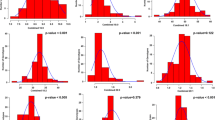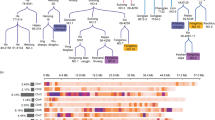Abstract
Oil content in cottonseed is a major quality trait which when improved through breeding could enhance the competitiveness of cottonseed oil among other vegetable oils. Cottonseed oil content is a quantitative trait controlled by genes in the tetraploid embryo and tetraploid maternal plant genomes, and the knowledge of quantitative trait loci (QTLs) and the genetic effects related to oil content in both genomes could facilitate the improvement in its quality and quantity. However, till date, QTL mapping and genetic analysis related to this trait in cotton have only been conducted in the tetraploid embryo genome. In the current experiment, an IF2 population of cottonseed kernels from the random crossing of 188 intraspecific recombinant inbred lines which were derived from the hybrid of two parents, HS46 and MARCABUCAG8US-1-88, were used to simultaneously locate QTLs for oil content in the embryo and maternal plant genomes. The four QTLs found to be associated with oil content in cottonseed were: qOC-18-1 on chromosome 18; qOC-LG-11 on linkage group 11; qOC-18-2 on chromosome 18; and qOC-22 on chromosome 22. At a high selection threshold of 0.05, there was strong evidence linking the QTLs above the oil content in cottonseed. Embryo additive and dominant effects from the tetraploid embryo genome, as well as maternal additive effects from the tetraploid maternal plant genome were found to be significant contributors to genetic variation in cottonseed oil content.


Similar content being viewed by others
References
Alrefai R., Berke T. and Rocheford T. 1995 Quantitative trait locus analysis of fatty acid concentrations in maize. Genome 38, 894–901.
Ash M. and Dohlman E. 2006 Oil crops situation and outlook yearbook. Electronic outlook report from the Economic Research Service. United States Department of Agriculture, Washington, USA.
Ashokkumar K. and Ravikesavan R. 2008 Genetic studies of combining ability estimates for seed oil, seed protein and fibre quality traits in upland cotton (G. hirsutum L.). Res. J. Agric. Biol. Sci. 4, 798–802.
Azhar F. M. and Ahmad M. 2000 Inheritance pattern of cotton seed oil in diverse germplasm of G. hirsutum L. Pak. J. Biol. Sci. 3, 1250–1252.
Bert P. F., Jouan I., Tourvieille L. D., Serre F., Philippon J., Nicolas P. and Vear F. 2003 Comparative genetic analysis of quantitative traits in sunflower (Helianthus annuus L.). 2. Characterization of QTL involved in developmental and agronomic traits. Theor. Appl. Genet. 107, 181–189.
Brummer E. C., Graef G. L., Orf J., Wilcox J. R. and Shoemaker R. C. 1997 Mapping QTL for seed protein and oil Content in eight soybean populations. Crop Sci. 37, 370–378.
Burns M. J., Barnes S. R., Bowman J. G., Clarke M. H. E., Werner C. P. and Kearsey M. J. 2003 QTL analysis of an intervarietal set of substitution lines in Brassica napus: (i) Seed oil content and fatty acid composition. Heredity 90, 39–48.
Chao K. G. 2009 Construction of genetic linkage map based on RIL population of upland cotton (G. hirsutum L.) and QTL mapping for yield and fiber quality. Ph.D. thesis, pp. 38–41. Zhejiang University, College of Agriculture and Biotechnology, Hangzhou, China.
Cherry J. P., Kohel R. J., Jones L. A. and Powell W. H. 1981 Cottonseed quality: factors affecting feed and food uses. In Proceedings of the Beltwide Cotton Production Reseasrch Conference (ed. J. M. Brown), pp. 266–283. National Cotton Council, Memphis, USA.
Connell J. P., Pammi S., Iqbal M. J., Huizinga T. and Reddy A. S. 1998 A high throughput procedure for capturing microsatellites from complex plant genomes. Plant Mol. Biol. Rep. 16, 341–349.
Dani R. G. 1990 Genetic research of cottonseed oil: a review. Coton Fibr. Trop. 45, 71–75.
Dani R. G. and Kohel R. J. 1989 Maternal effects and generation mean analysis of seed oil content in cotton (Gossypium hirsutum L.). Theor. Appl. Genet. 77, 569–575.
Dowd M. K., Boykin D. L., Meredith W. L., Campbel B. T., Bourland F. M., Gannaway J. R. et al. 2010 Fatty acid profiles of cottonseed genotypes from the national cotton variety trials. J. Cotton Sci. 14, 64–73.
Hamilton K. A., Pyla P. D., Breeze M., Oslon T., Li M., Robinson E. et al. 2004 Bollgard II cotton: compositional analysis and feeding studies of cottonseed from insect-protected cotton (Gossypium hirsutum L.) producing the Cry 1Ac and Cry 2Ab2 proteins. J. Agric. Food Chem. 52, 6969–6976.
Han Z. G., Guo W. Z., Song X. L. and Zhang T. Z. 2004 Genetic mapping of EST-derived microsatellites from the diploid Gossypium arboreum in allotetraploid cotton. Mol. Genet. Genomics 272, 308–327.
Karademir C., Gencer O. and Karademir E. 2007 Heterosis and combining ability for yield and fiber properties in cotton (Gossypium hirsutum L.) under drought stress conditions. Asian J. Plant Sci. 6, 667–672.
Khan N. U., Hassan G., Kumbhar M. B., Parveen A., Um-e-Aiman, Ahmad W. et al. 2007 Gene action of seed traits and oil content in upland cotton (Gossypium hirsutum L.). J. Breed. Genet. 39, 17–29.
Kohel R. J. 1980 Genetic studies of seed oil in cotton. Crop Sci. 20, 784–787.
Kosambi D. D. 1944 The estimation of map distance from recombination values. Ann. Eugen. 12, 172–175.
Kumpatla S. P., Horne E. C., Shah M. R., Gupta M. and Thompson S. A. 2002 Development of SSR markers: towards genetic mapping in cotton (Gossypium hirsutum L). Abstract communication at the 3rd International Cotton Genome Initiative Workshop, Nanjing. China Cotton Sci. 14, 28.
Leon A. J., Andrade F. H. and Lee M. 2003 Genetic analysis of seed-oil concentration across generations and environments in sunflower. Crop Sci. 43, 135–140.
Liu P., Wang C. M., Li L. F., Liu S. P. and Yue G. H. 2011 Mapping QTLs for oil traits and eQTLs for oleosin genes in jatropha. BMC Plant Biol. (doi: 10.1186/1471–2229–11–132).
McCouch S. R., Cho Y. G., Yano P. E., Blinstrub M., Morishima H. and Kinoshita T. 1997 Report on QTL nomenclature. Rice Genet. Newslett. 14, 11–13.
Nguyen T. B., Giband M., Brottier P., Risterucci A. M. and Lacape J. M. 2004 Wide coverage of the tetraploid cotton genome using newly developed microsatellite markers. Theor. Appl. Genet. 109, 167–175.
Pahlavni M. H., Miri A. A. and Kazemi G. 2008 Response of oil and protein content to seed size in cotton. Int J. Agric. Biol. 10, 643–647.
Park Y. H., Alabady M. S., Ulloa M., Sickler B., Wilkins T. A., Yu J. et al. 2005 Genetic mapping of new cotton fiber loci using EST-derived microsatellites in an interspecific recombinant inbred (RIL) cotton population. Mol. Genet. Genomics 274, 428–441.
Qin L., Shen X. J., Chen J. H. and Zhu S. J. 2010 Determination of protein and gossypol content in cotton kernel powder with near infrared reflectance spectroscopy. Spectrosc. Spect. Anal. 30, 635–639.
Ramos L. C. D. S. 1985 A genetic study of cottonseed oil content associated with glanded and glandless strains. Ph.D. thesis, Texas A & M University, College Station, Texas, USA.
Reddy O. U. K., Pepper A. E., Abdurakhmonov I., Saha S., Jenkins J. N., Brooks T. B. et al. 2001 New dinucleotide and trinucleotide microsatellite marker resources for cotton genome research. J. Cotton Sci. 5, 103–113.
Saha S., Karaca M., Jenkins J. N., Zipf A. E., Reddy U. K. and Kantety R. V. 2003 Simple sequence repeats as useful resources to study transcribed genes of cotton. Euphytica 130, 355–364.
Shappley Z. W., Jenkins J. N., Zhu J. and McCarty Jr J. C. 1998 Quantitative trait loci associated with agronomic and fiber traits of upland cotton. J. Cotton Sci. 4, 153–163.
Shi C. H., Shi Y., Lou X. Y., Xu H. M., Zheng X. and Wu J. G. 2009 Identification of endosperm and maternal plant QTLs for protein and lysine contents of rice across different environments. Crop Pasture Sci. 60, 295–301.
Singh M., Singh T. H. and Chalal G. S. 1985 Genetic analysis of some seed quality characters in upland cotton. Theor. Appl. Genet. 71, 126–128.
Song X. L. and Zhang T. Z. 2007 Identification of quantitative trait loci controlling seed physical and nutrient traits in cotton. Seed Sci. Res. 17, 243–251.
Ulloa M., Cantrell R. G., Percy R. G., Lu Z. M. and Zeiger E. 2000 QTL analysis of stomatal conductance and relationship to lint yield in an interspecific cotton. J. Cotton Sci. 4, 10–18.
Van Heerden H. G. 1969 Analysis of seed components in upland cotton and their associations with lint percentage. Ph.D. dissertation, pp. 21. Texas A&M University, College Station, USA.
Wang S. 2000 Simulation study on the methods mapping quantitative trait loci in inbred line crosses. A dissertation submitted in partial fulfillment of the requirement for the degree of Doctor of Philosophy in Genetics and Plant Breeding Zhejiang University, Hangzhou, Zhejiang, China.
Weil A. 2007 Eight weeks to optimum health: a proven program for taking full advantage of your body’s natural healing power, pp. 8–28. Random House Publishing Group, New York, USA.
Wu J. G., Shi C. H. and Zhang X. M. 2002 Estimating the amino acid composition in the milled rice powder by near-infrared reflectance spectroscopy. Field Crops Res. 75, 1–7.
Wu J., McCarty J. C. and Jenkins J. N. 2010 Cotton chromosome substitution lines crossed with cultivars: Genetic model evaluation and seed trait analyses. Theor. Appl. Genet. 120, 1473–1483.
Yang J., Zhu J. and Williams R. W. 2007 Mapping the genetic architecture of complex traits in experimental populations. Bioinformatics 23, 1527–1536.
Yu J., Park Y. H., Lazo G. R., Wolf N. C. and Kohel R. J. 1996 Molecular mapping of the cotton genome and its applications in cotton improvement. In Proceedings of the Beltwide Cotton Conferences, Vol. I, pp. 636. The Cotton Foundation, Cordova, Tennessee.
Yu J., Yu S., Fan S., Song M., Zhai H., Li X. and Zhang J. 2012 Mapping quantitative trait loci for cottonseed oil, protein and gossypol content in a Gossypium hirsutum × Gossypium barbadense backcross inbred line population. Euphytica 187, 191–201.
Yu Z. H. and Kohel R. J. 1999 Cotton genome mapping and applications. In Proceedings from the Plant and Animal Genome Comference VII, pp. 60. San Diego, CA.
Zhao J., Dimov Z., Becker H. C., Ecke W. and Möllers C. 2008 Mapping QTL controlling fatty acid composition in a doubled haploid rapeseed population segregating for oil content. Mol. Breed. 21, 115–125.
Zheng X., Wu J. G., Lou X. Y., Xu H. M. and Shi C. H. 2008 QTL Analysis of maternal and endosperm genomes for histidine and arginine in rice (Oryza sativa L.) across environments. Acta Agron. Sin. 34, 369–375.
Zhu J. and Weir B. S. 1994 Analysis of cytoplasmic and maternal effects I.A genetic model for diploid plant seed and animals. Theor. Appl. Genet. 89, 153–159.
Zhu J. and Weir B. 1998 Mixed model approaches for genetic analysis of quantitative traits, In Advanced topics in biomathematics: Proceedings of the International Conference on Mathematical Biology (eds. L. Chen, S.G. Ruan and J. Zhu), pp. 321–330. World Scientific Publishing Co., Singapore.
Acknowledgements
This project was supported by the National High Technology Research and Development Programme of China (2009AA101104), Programme for Innovative Research Team in University (IRT1185), the Fundamental Research Funds for the Central Universities, and 151 Foundation for the Talents of Zhejiang province.
Author information
Authors and Affiliations
Corresponding authors
Additional information
[Alfred Q., Liu H. Y., Xu H. M., Li J. R., Wu J. G., Zhu S. J. and Shi C. H. 2012 Mapping of quantitative trait loci for oil content in cottonseed kernel. J. Genet. 91, xx–xx]
†These authors contributed equally to this work
Rights and permissions
About this article
Cite this article
ALFRED†, Q., LIU†, H.Y., XU, H.M. et al. Mapping of quantitative trait loci for oil content in cottonseed kernel. J Genet 91, 289–295 (2012). https://doi.org/10.1007/s12041-012-0184-0
Received:
Revised:
Accepted:
Published:
Issue Date:
DOI: https://doi.org/10.1007/s12041-012-0184-0




